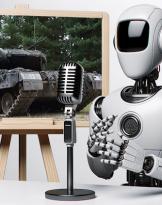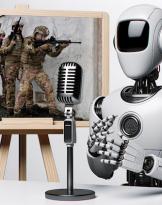In a world in which the politically correct or the politically "appropriate" dictate the rules of information and now of thought, there is a neutral and neutral source capable of candidly answering almost all questions: Artificial Intelligence (except current and future algorithms to gag her). ChatGPT is a version accessible to anyone that helps us understand the potential and dangers of an intelligence stripped of its many human masks and hypocrisies.
We ask new questions to "GAIA" (Great Artificial Intelligence Alarm), the same ones that - if asked to a human being - would lead to easy prejudice or criticism towards the source.
What are the characteristics for an organization to be defined as a "union"?
To be able to define itself as a "union", an organization must possess certain characteristics that distinguish it from other forms of associations or interest groups. These characteristics are essential to understanding what makes an organization a real union. Here are the main criteria:
Workers' representation
A trade union is first and foremost an organization that represents workers in a specific sector, company or profession. Its main function is to act as an intermediary between workers and employers or the government.
Collective negotiation
The power to collectively negotiate employment contracts is one of the most important functions of a union. These contracts regulate wages, hours of work, working conditions, benefits and other employment matters. Collective bargaining is a key tool that unions use to improve conditions for their members.
Right to strike
Another fundamental aspect of unions is the ability to organize strikes or other collective actions as a form of pressure on employers to improve working conditions or resolve labor disputes. This is considered an essential right for effective trade union activity.
Independence
To call itself a union, the organization must be independent of both employers and the government. This independence is crucial to enable the union to operate in the best interests of its members without conflicts of interest.
Self-management
Trade unions are generally managed and controlled by their members, through internal democratic mechanisms. This includes electing representatives, voting on important issues such as ratifying employment contracts or deciding to strike.
Legality
A trade union must be legally recognized in the national context in which it operates. This recognition can vary widely from country to country, but typically includes registration with a relevant government agency and compliance with local laws relating to union activity.
Protection and promotion of labor rights
Finally, trade unions aim to protect and promote the labor and social rights of their members. This includes not only negotiating favorable working conditions, but also protecting workers from discrimination and abuse, and promoting workplace equity and safety policies.
These characteristics outline the classic profile of a union and distinguish these organizations from other types of groups or associations that may exist in the world of work. In contexts where some of these functions are limited by law, as is the case with military personnel in many countries, existing organizations may not be classified as trade unions in the full sense of the term.
What are the levers of the "military unions" to make themselves heard, not being able to strike or demonstrate (except with many limitations)?
In contexts where military personnel are organized into union-like associations or entities, but are not allowed to strike or demonstrate publicly due to legal and disciplinary restrictions, there are several alternative strategies they can use to be heard and influence decisions. Here are some of the main levers and methods adopted:
Lobbying and Advocacy
These associations can lobby legislators and policy makers to influence legislation and policies that impact military personnel. Lobbying can be done through face-to-face meetings, drafting position papers, and participating in committees or parliamentary hearings.
Collaboration with the media
Using the media to raise awareness about specific issues is another effective strategy. Through press releases, interviews, opinion articles and collaborations with journalists, associations can bring their concerns to public attention and indirectly pressure policy makers through public opinion.
Lawsuits
Associations can take legal action against laws or policies deemed unfair or discriminatory. This includes litigation to defend members' rights or to challenge adverse administrative decisions.
Indirect negotiation
Even if they cannot participate directly in collective negotiations, they can influence the negotiation process by providing data, studies, and testimonies that can be used by others (such as political representatives or advisory bodies) who have the power to negotiate.
Training and information
Educating and informing your members about rights, laws and policies can strengthen the rank and file, making the military more aware of their options and rights. This may include training on how to behave in legal situations, rights outside of military service, and more.
Support network
Offering legal, psychological, and professional support to members can not only improve the quality of life of service members, but also build solidarity and unity that can strengthen the group's position when discussing its demands with higher authorities.
Participation in commissions or advisory boards
Some countries have established advisory councils or commissions in which representatives of military associations can participate. These bodies serve to provide feedback and recommendations to the Ministry of Defense or other government entities.
Internal awareness campaigns
Organizing awareness and information campaigns within the military can help rally internal support for specific issues, creating bottom-up pressure that can be difficult for higher commands to ignore.
Using these strategies, associations similar to military unions seek to overcome the limitations imposed by their unique position and work within legal and regulatory boundaries to represent and defend the interests of their members. These methods often require creativity and perseverance, but can be effective in promoting change and improving conditions for military personnel.
Have there ever been cases of public protests or protests in the military sector?
Yes, throughout history there have been several cases of public protests or protests within the armed forces of various countries, despite severe regulatory restrictions and limitations imposed on military personnel regarding trade union activity and the right to strike. Here are some notable examples of such protests:
Revolt of the admirals (USA, 1949)
The "Revolt of the Admirals" is a famous episode of dissent within the United States Navy, when several high-ranking admirals publicly opposed the decision of Secretary of Defense Louis Johnson and President Harry S. Truman to reduce the number of aircraft carriers to favor of the B-36 strategic bomber. This dissent included testimony before Congress and a series of letters and memoirs that openly criticized defense policies.
Bonus army (USA, 1932)
The "Bonus Army" was a group of approximately 43,000 protesters, mostly World War I veterans and their families, who marched on Washington, D.C., to demand immediate payment of a bonus that had been promised for their service. The situation culminated in the intervention of the United States Army to disperse the demonstrators, causing considerable public scandal.
French Army mutinies (France, 1917)
During World War I, in 1917, there were large uprisings (about 54 French regiments) in the French army on the Western Front. The troops, tired and demoralized by continuous unsuccessful offensives and heavy losses, refused to continue the attacks. The revolts were suppressed, but led to significant changes in military strategies and improvements in the conditions of the soldiers.
Cronstadt rebellion (Russia, 1921)
The Cronstadt Uprising was one of the most serious threats to Soviet power in the post-revolutionary period. The sailors of the Cronstadt naval base, once loyal supporters of the October Revolution, rebelled against the economic and political policies of the Bolshevik government, demanding democratic reforms. The uprising was brutally suppressed by the Red Army.
German military protests against nuclear weapons (Germany, 80s)
During the 80s, there were several cases of dissent among German military personnel regarding NATO's policy of deploying nuclear weapons in Europe. These included public protests and statements against the nuclear deterrent policy.
These episodes demonstrate how, despite restrictions, military personnel in various historical and geographic contexts have found ways to express dissent and demand change. Such movements have often been motivated by issues of fairness, living conditions, contested military policies, or economic rights, reflecting the importance of justice and well-being issues even within the military.








